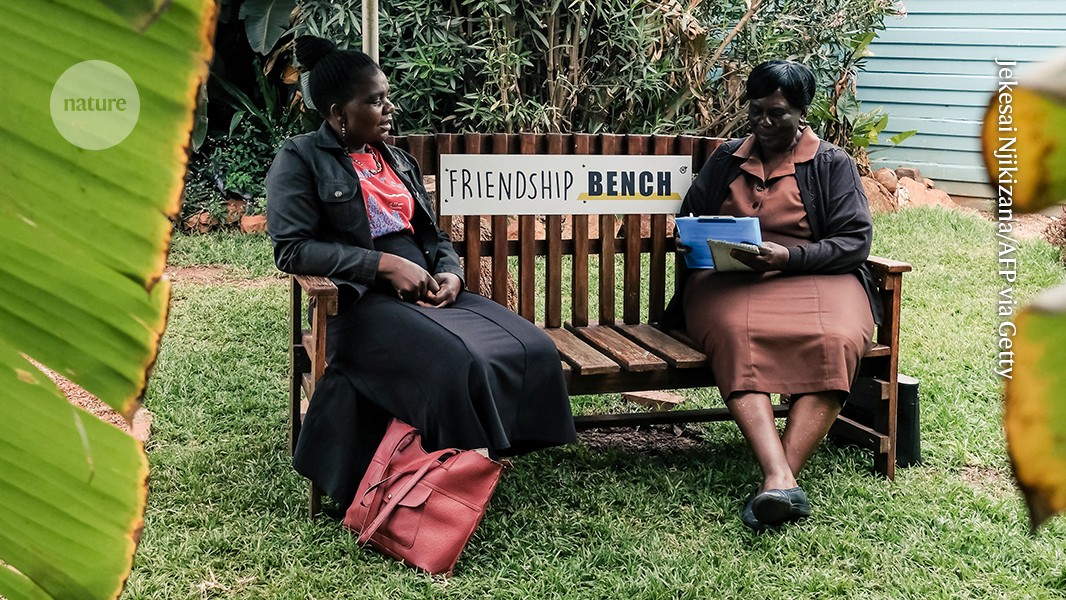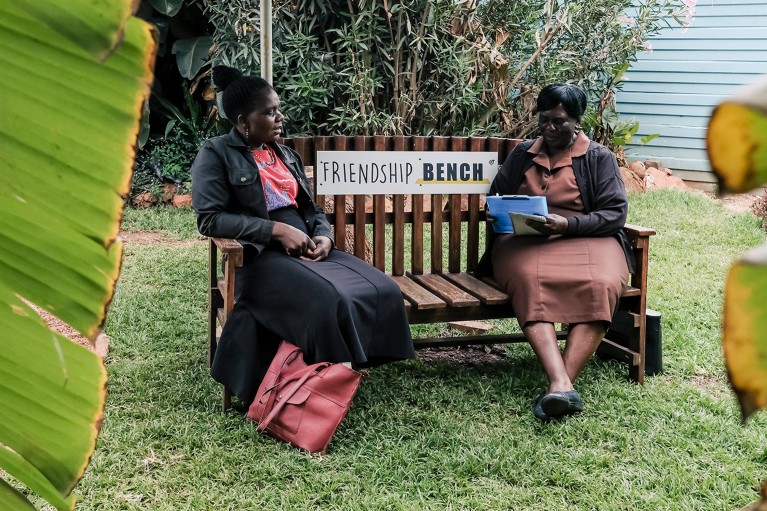
A client (left) has a counselling session with a lay therapist on a Friendship Bench in Harare.Credit: Jekesai Njikizana/AFP via Getty
Kisumu, Kenya
As the bells ring out at Archbishop Okoth Ojolla Girls’ High School, 900 students descend onto a field, carrying brightly coloured chairs. Every week for a month, the students have been gathering in small groups as local secondary-school graduates lead therapy sessions.
Whitney Ndemo, a psychologist at TINADA Youth Action Africa in Kisumu, was standing nervously to one side. A supervisor for the programme, Ndemo was thinking about a student from another school, who had been referred to her after he tried to take his own life. “He has been through a number of traumas,” Ndemo says, including his father’s death and his mother’s rape and murder. His friends and teachers were of little comfort, but he opened up to these older peers, who promised to keep his secret — and to help. (If you or someone you know is contemplating suicide, please reach out through https://findahelpline.com.)
The huge toll of PhDs on mental health: data reveal stark effects
The Shamiri Institute, a non-profit mental-health organization in Nairobi, has been developing programmes such as the one at Archbishop Okoth Ojolla since 2021. The goal is to train 18–22-year-olds to provide counselling that enhances students’ resilience and problem-solving skills, and to triage and refer severe cases to clinical supervisors such as Ndemo. The model is part of a shift in mental health, leaning on secondary-school graduates, grandmothers, community health workers and other laypeople to expand access to care.
The thinking behind the model is not that psychiatrists and psychologists are unnecessary, but rather that there aren’t enough of them. According to the World Health Organization, in 2022, Africa had fewer than 2 mental-health workers per 100,000 people, so many individuals with mental illness are unable to access care, potentially contributing to African countries having some of the highest suicide rates in the world.
Lay providers can help to fill the gap, treating common mental-health conditions with comparable and sometimes better outcomes than professionals can, according to John Naslund, a psychiatric epidemiologist at Harvard Medical School in Boston, Massachusetts. “We’ve now got strong evidence backed by well over 100–150 randomized controlled trials,” he says. “We can take mental health care out of formal, specialist-delivered settings.”
And although much of the foundational research has been done in Africa and South Asia, lay-provider models are now being piloted around the world. Countries from across income levels are seeking ways to expand access to care and intervene early. But transforming laypeople into mental-health providers carries inherent risks, from rapid burnout to quality-control issues. With the stakes sometimes life or death, many are exploring whether mental-health services can or should move from the clinic to the community.
Challenges and chances in Africa
Almost every country is facing a mental-health crisis. According to a survey analysis1 that focused on 29 nations, one in 2 people around the world will develop a mental-health disorder by age 75. The drivers vary widely, from social isolation and loneliness to trauma resulting from violence, poverty and more.
In one study in Kenya, around 30% of adolescents reported experiencing anxiety or depression2, compared with about 20% in the United States (see go.nature.com/3gdxrre). Alex Yomba, a final-year student at Alliance High School in Kikuyu, says that one big factor is a culture that discourages people from seeking help: “We are Africans; it doesn’t suit you to say, ‘I have a mental issue.’ Most people hide it.”
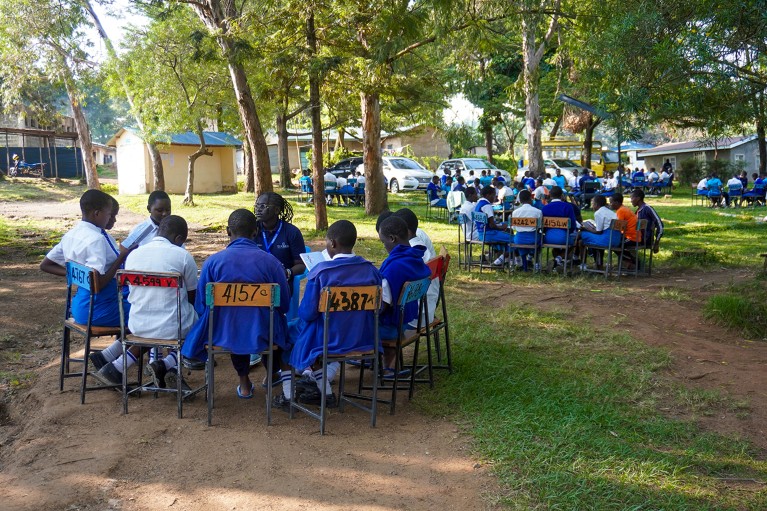
Students at Archbishop Okoth Ojolla Girls’ High School in Kisumu, Kenya, attend therapy sessions run by older peers.Credit: Jonathan Kennedy
But even if Yomba or his friends wanted to access care, they probably wouldn’t be able to. Kenya has a population of 55 million, but only about 100 psychiatrists and perhaps 400 psychologists, according to Gladys Mwiti, a psychologist and retired teacher in Kenya.
Tom Osborn, who co-founded the Shamiri Institute in 2018, says that this shortfall is remarkable in its universality. “The West really hasn’t figured it out,” Osborn says. More than half of people in the United States, for example, live in places that have a shortage of mental-health professionals, according to national statistics (see go.nature.com/3yf6rqj).
At the age of 23, Osborn set out to build a mental-health model that was innovative, scalable and competitive globally. He was inspired by the late psychiatrist Thomas Lambo, who pioneered community psychiatry in Nigeria in the 1950s and 1960s.
The key to the Shamiri programme’s success is that group sessions are framed not around treating mental illness, but around promoting positive psychology, according to Brenda Ochuku, former research manager at the Shamiri Institute. Students at Archbishop Okoth Ojolla open up about their sadness and anxiety — either in groups or individually afterwards — because the focus is on well-being, as the girls learn about loving themselves, practising gratitude and embracing a growth mindset. “If you go to schools and say ‘we want to talk to students about depression and suicidality’, you’re not really going to get the best response,” Ochuku says.
High mental health burden for Africa’s youth
It’s a counter-intuitive approach, but one that is gaining traction. Shamiri is working with 100,000 students this year and is on track to reach one million annually by 2027. Proponents say that much of its appeal stems from a strong research foundation. In one trial, 413 students across 4 secondary schools in Kenya were assigned to either the Shamiri intervention or a series of group sessions to teach study skills3. Seven months later, the number of students with symptoms of depression or anxiety had dropped by about 80% in the Shamiri group compared with 37% in the control group, according to Osborn. He and his collaborators concluded that with just 10 hours of training, lay providers could help to promote sustainable mental-health improvements.
Other lay-provider programmes have shown similar results, such as StrongMinds, a non-profit organization in Kampala, Uganda, that treats depression using a network of community health workers and people with a history of mental illness. To reduce distress, the providers are trained to help clients mend and strengthen relationships, says Myrna Weissman, a member of the StrongMinds advisory board and a psychiatric epidemiologist at Columbia University in New York City.
The idea for StrongMinds came from a trial that Weissman published in 2003, which showed that interpersonal group therapy helped to reduce depression by around 80 percentage points (from 86% to 7%) across 30 villages in rural Uganda, compared with a reduction of around 40 percentage points (from 94% to 55%) for the no-treatment control group4. This was a 16-week-long intervention, but in further trials, StrongMinds showed the programme can be effective in as few as 6, and with markedly better retention (results from the 6-week therapy have not yet been published). “We still saw 75% of our clients coming out of therapy depression-free,” says Vincent Mujune, the country director of StrongMinds in Uganda.
Friendship Bench Zimbabwe, a non-profit mental-health organization in Harare, similarly trains grandmothers in problem-solving therapy, so that they can help to treat anxiety and depression. These older women sit on nondescript wooden benches, usually around community clinics, and offer one-to-one counselling sessions to individuals wanting to chat.
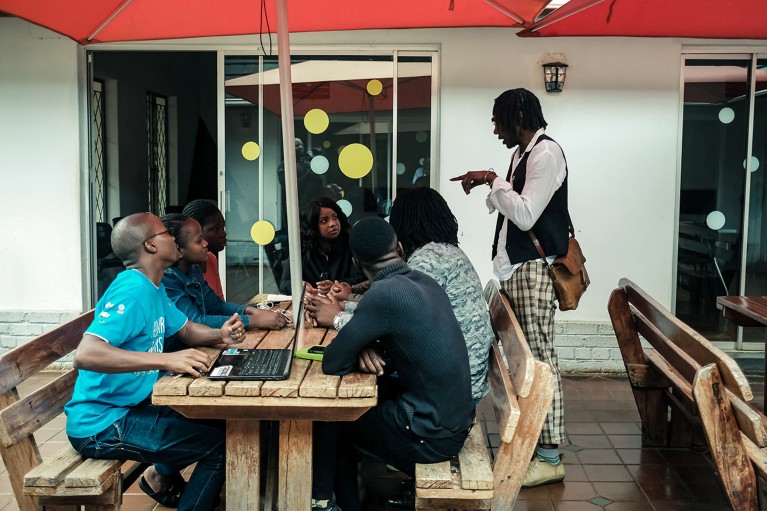
Psychiatrist Dixon Chibanda (standing), founder of Friendship Bench, speaks to staff in Harare.Credit: Jekesai Njikizana/AFP via Getty
In 2016, Dixon Chibanda, a psychiatrist at the University of Zimbabwe in Harare and the London School of Hygiene & Tropical Medicine, and his team compared Friendship Bench to enhanced standard care, which consisted of brief supportive counselling, medication and general informational resources. After six months, 50% of the people in this control group were depressed, compared with 14% of those who received the Friendship Bench intervention. Anxiety symptoms and suicidal thoughts were four to five times lower in the Friendship Bench group5.
“We have strong evidence that when layperson models are adapted to different cultures, contexts and environments, they retain that level of effectiveness,” says Naslund. “It’s very rare that you have this level of clinical evidence and support.”
Note of caution
Some researchers express caution about extrapolating these results. Judith Bass, a psychiatric epidemiologist at Johns Hopkins University in Baltimore, Maryland, says that she is impressed by the duration of improvements, which seem to last for several months after the intervention. But she adds that longer-term studies are needed. “I would want to see a year later follow-up,” says Bass. “Many of those effects go away at 6 months, 8 months, 12 months because depression is hard to treat.”
The findings might also reflect a self-reporting bias, says Brandon Knettel, a psychologist at Duke University in Durham, North Carolina. After any mental-health intervention, participants could say they’re feeling better out of gratitude or because they think that is what researchers want to hear. He adds that there’s often a gap between the findings of highly controlled trials — given they have optimal supervision, monitoring and evaluation — and everyday practice.
Nevertheless, systematic reviews in low- and middle-income countries have shown that lay-provider models have moderate to strong effects in reducing the burden of common mental-health disorders6. For depression specifically, a meta-analysis found that these models elicit larger reductions in symptoms and better long-term outcomes than control interventions such as psychological care do7.
Knettel describes many of these lay-provider models as skill-building interventions, which might explain some of the positive outcomes. Unlike antidepressant drugs, which are often prescribed on a continuous basis, these skills can be called on as needed during a person’s lifetime.
After the genocide: what scientists are learning from Rwanda
Lay providers also typically bring a shared culture, language and understanding. “You’re breaking down hierarchies between providers and people using services,” says Liana Chase, a medical anthropologist at Durham University, UK. That helps to reach people who might otherwise be ashamed or reluctant to seek formal care.
Still, lay providers cannot replace trained mental-health professionals. These models have not yet proved to be as strong an intervention for schizophrenia, post-traumatic stress disorder or severe mental-health conditions more generally, says Knettel. Lay providers are also at high risk of burnout, given their limited training and the taxing nature of the work. “When students share their issues with you, their challenges, maybe it relates to something in you,” says Scholastica Mutheu, a lay provider working with Shamiri in Kisumu. “It took me a lot of courage to be strong.”
Given these challenges, Chase says there’s a risk that lay-provider models “could become something like second-class care for the poor”. But she adds that the programmes can have some safeguards, such as regular supervision and integration with formal health-care systems — to refer people to higher levels of care. To Chase, the biggest research question is not whether lay-provider models can be successful, but how to set them up to ensure sustainable, high-quality care.
A growing movement
Lay-provider models are starting to expand throughout Africa and beyond. Friendship Bench has been successfully replicated in Tanzania, Malawi, Jordan and Vietnam, and Shamiri has spread to Ethiopia and South Africa, with plans to expand to Brazil and Ecuador next year.
Camila Moreno, executive director of Ilumine, a mental-health non-profit organization in São Paulo, Brazil, says her organization chose to pilot the Shamiri model because it had some of the most compelling evidence. It also allows for proactive engagement, reaching all students in a system, regardless of their mental-health status or willingness to seek help. But all the various lay-provider programmes have parts to play, Moreno says, because “every country needs this work”.
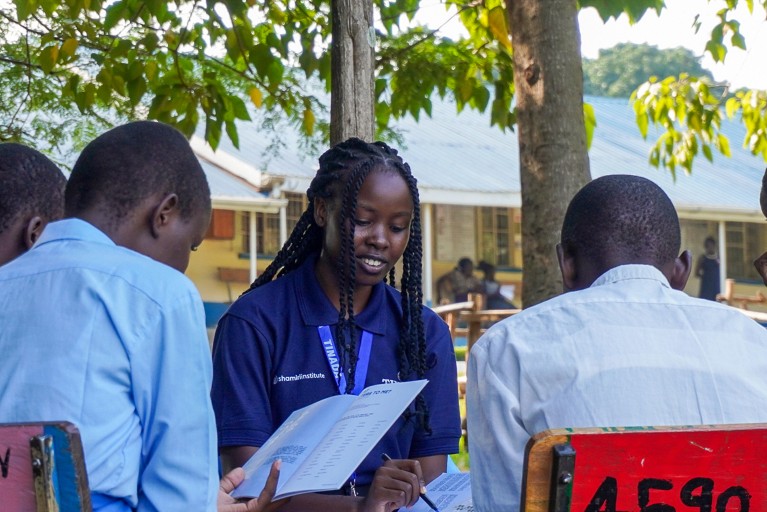
The therapy programme at Archbishop Okoth Ojolla is run by the Shamiri Institute, a mental-health non-profit organization in Nairobi.Credit: Jonathan Kennedy
Many of the programmes have been expanded in high-income countries. For example, StrongMinds treated nearly 240,000 people with depression in 2023, mostly in Uganda and Zambia, and it extended this year to northern New Jersey. Similarly, Friendship Bench started working in Washington DC this summer, focusing on the most underserved parts of the city, according to Cindy Cox-Roman, chief executive of HelpAge USA, the non-profit organization based in Washington DC that is running the project. “We are not trying to replace mental-health professionals; it’s about providing another point of access, because people are dying,” she says.
How to recover when a climate disaster destroys your city
The benches have sprung up near a few schools, churches and senior centres across southern Washington DC, adorned with houseplants, sunflower rugs and throw pillows that invite people to stay awhile. As Tuere Marshall, one of the grandmother lay providers, sees it, the problem is not only a shortage of professionals but also the available services not being welcoming or accessible to all.
“The medical track record within the African American community is very dicey,” Marshall says, and that’s why many of her friends and family members resist seeking formal help. But coming from the community, Marshall can meet people where they are and help them to find a solution without judgement. “We don’t stop at the first issue that they bring up,” she says. “We let them talk until they’re finished.”
Many lay-provider models in high-income countries are in their early days, and it’s not clear how long they’ll last. A Friendship Bench programme launched in New York City in 2017, but closed four years later after funding dried up when the mayor left office.
Uncertain future
The pull towards operating in wealthy nations, Osborn says, comes from it being easier to raise money in those places. He has, however, resisted expanding Shamiri into high-income countries because, he says, “the biggest need is in Africa”.
Still, Osborn can’t escape the larger question of how to finance these models. There’s little profit to be made and thus limited investment, says Weissman. “If a company gets a new drug and shows it works in two clinical trials, they will spend millions of dollars distributing and giving free samples, advertising it.”
There is also limited interest among insurers and health-care systems to pay for community-led services, says Bass. As such, these models are heavily reliant on philanthropy. Leaders at Shamiri, StrongMinds and Friendship Bench all say this isn’t viable in the long term. “We need real money to scale this and make it sustainable,” says Osborn.
Lay-provider models can be labour-intensive, given the training and supervision costs but, compared with conventional mental health care, they are relatively inexpensive to deliver, from US$7 per person for Shamiri to $18 for Friendship Bench and $31 for StrongMinds. Osborn thinks these prices can come down, but the big question is whether African governments will pay for it, given that mental health has long been underfunded on the continent.
Ndemo remains optimistic. She knows lay providers have what it takes to catch people who fall through the cracks, and to help save lives. For the boy who was referred to her with suicidal intentions, these providers had created a space where he felt safe opening up, where “he had the chance to share with someone who showed concern and really related with what he was going through”, Ndemo says. In a world where trained professionals are scarce, sometimes what’s most important is having someone who is willing to listen.


